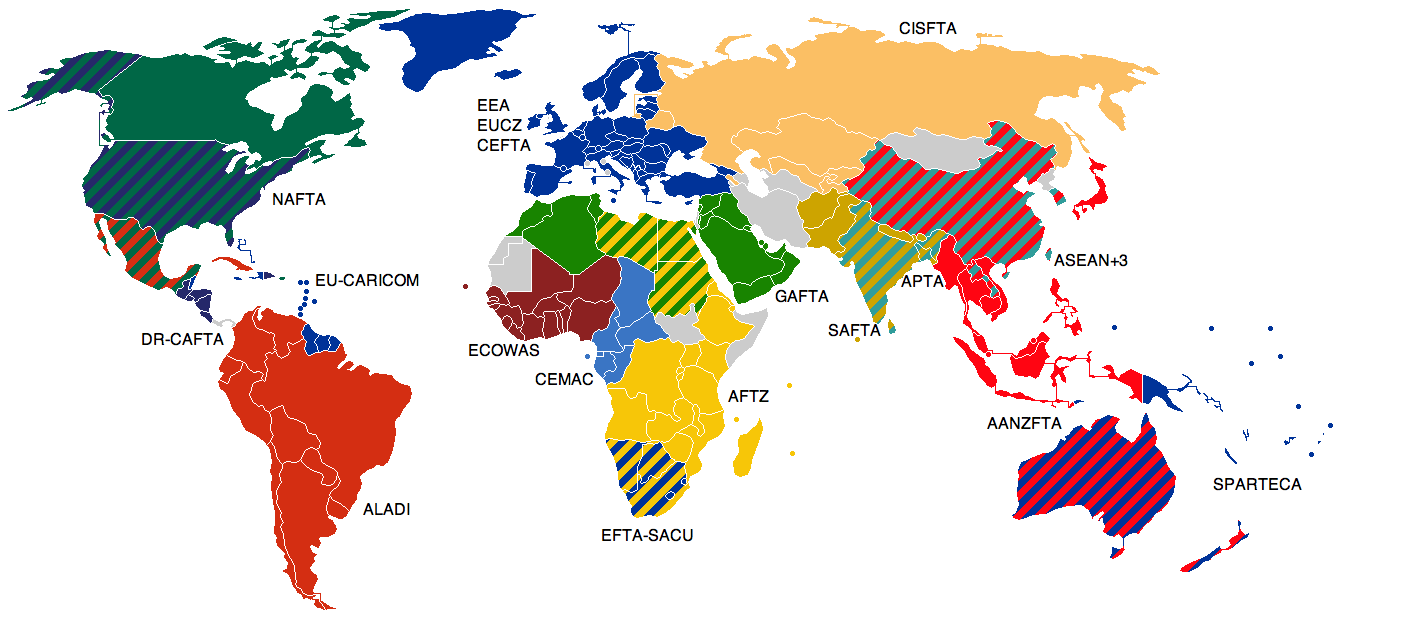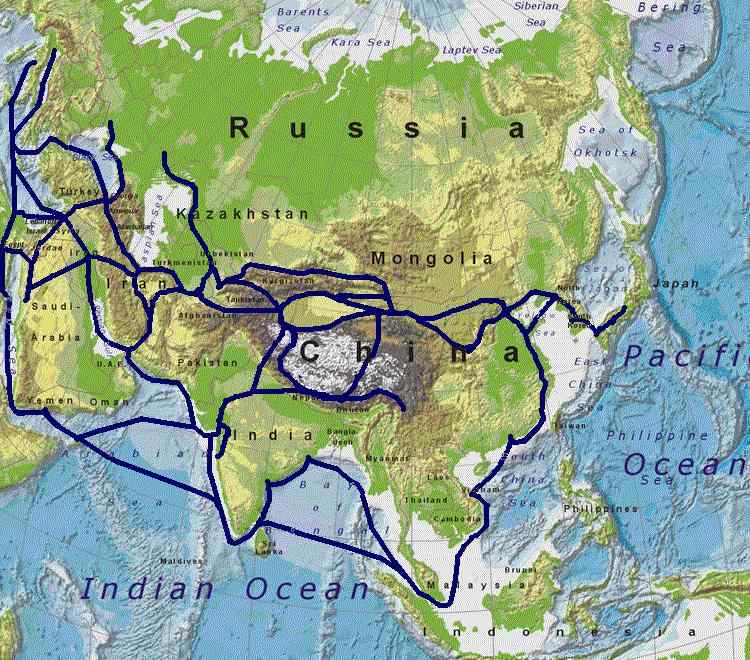|
Morocco–United States Free Trade Agreement
The US-Morocco Free Trade Agreement (or Morocco FTA) is a bilateral trade agreement between the United States and Morocco. The agreement was signed on June 15, 2004, followed by U.S. President George W. Bush's signing of the USMFTA Implementation Act on August 17, 2004. The United States House of Representatives ratified the pact on July 22, 2004 by a 323–99 vote. The United States Senate passed the bill by unanimous consent on July 21, 2004. The Morocco FTA came into effect on January 1, 2006. It was, as of 2011, one of nine free trade agreements entered into by the U.S. since 1985.Free Trade Agreements , Office of the United States Trade Representative Ustr.gov (2011-10-21). Retrieved on 2012-08-18. The agreement is aimed at increasing trade and crea ... [...More Info...] [...Related Items...] OR: [Wikipedia] [Google] [Baidu] |
Bilateral Trade
Bilateral trade or clearing trade is trade exclusively between two states, particularly, barter trade based on bilateral deals between governments, and without using hard currency for payment. Bilateral trade agreements often aim to keep trade deficits at minimum by keeping a clearing account where deficit would accumulate. The Soviet Union conducted bilateral trade with two nations, India and Finland. On the Soviet side, the trade was nationalized, but on the other side, also private capitalists negotiated deals. Relationships with politicians in charge of foreign policy were especially important for such businessmen. The framework limited the traded goods to those manufactured domestically and as such, constituted a subsidy to domestic industry. Bilateral trade was highly popular within Finnish business circles, as it allowed the commission of very large orders, additionally with less stringent requirements for sophistication or quality, if compared to Western markets. The So ... [...More Info...] [...Related Items...] OR: [Wikipedia] [Google] [Baidu] |
Euro-Mediterranean Free Trade Area
The European Union-Mediterranean Free Trade Area (EU-MED FTA, EMFTA), also called the Euro-Mediterranean Free Trade Area or Euromed FTA, is based on the Barcelona Process and European Neighbourhood Policy (ENP). The Barcelona Process, developed after the Barcelona Conference in successive annual meetings, is a set of goals designed to lead to a free trade area in the Mediterranean Region and the Middle East. A ''Regional Convention on pan-Euro-Mediterranean preferential Rules of Origin'' was signed in June 2011 to allow identical rules of origin across the region.The convention covers the EU, the EFTA, the EU customs unions with third states (Turkey, Andorra, San Marino), the EU candidate states, the partners of the Barcelona Process and possibly at a later stage all of the European Neighbourhood Policy partners.http://ec.europa.eu/world/agreements/prepareCreateTreatiesWorkspace/treatiesGeneralData.do?step=0&redirect=true&treatyId=9641 The convention was in force from May 201 ... [...More Info...] [...Related Items...] OR: [Wikipedia] [Google] [Baidu] |
Treaties Entered Into Force In 2006
A treaty is a formal, legally binding written agreement between sovereign states and/or international organizations that is governed by international law. A treaty may also be known as an international agreement, protocol, covenant, convention, pact, or exchange of letters, among other terms; however, only documents that are legally binding on the parties are considered treaties under international law. Treaties may be bilateral (between two countries) or multilateral (involving more than two countries). Treaties are among the earliest manifestations of international relations; the first known example is a border agreement between the Sumerian city-states of Lagash and Umma around 3100 BC. International agreements were used in some form by most major civilizations and became increasingly common and more sophisticated during the early modern era. The early 19th century saw developments in diplomacy, foreign policy, and international law reflected by the widespread use of treat ... [...More Info...] [...Related Items...] OR: [Wikipedia] [Google] [Baidu] |
Free Trade Agreements Of The United States
The United States is party to many free trade agreements (FTAs) worldwide. Beginning with the Theodore Roosevelt administration, the United States became a major player in international trade, especially with its neighboring territories in the Caribbean and Latin America. The United States helped negotiate the General Agreement on Tariffs and Trade (later the World Trade Organization). Active agreements The following agreements are currently in effect, signature and entry into force dates are as listed by the World Trade Organization. Negotiations The following agreements have begun negotiations since 2020. Obsolete agreements Failed proposals Free Trade Area of the Americas * * * * * * * * * * * * * * * * * * * * * * * * * * * * * * * * * * Trans-Pacific Partnership * * * * * * * * * * * Transatlantic Trade and Investment Partnership * See also * Bilateral Investment Treaty * European Union free trade agreements * Fre ... [...More Info...] [...Related Items...] OR: [Wikipedia] [Google] [Baidu] |
Economy Of Morocco
The economy of Morocco is a market economy, governed by the law of supply and demand. Since 1993, in line with many Western world changes, Morocco has followed a policy of privatisation. Morocco has become a major player in African economic affairs, and is the 6th largest African economy by GDP (PPP). The World Economic Forum placed Morocco as the most competitive economy in North Africa, in its African Competitiveness Report 2014–2015. The economic system of the country demonstrated resilience to the climate, commodity, and pandemic shocks of the early 2020s. As of 2022, Morocco had the eighth-highest GDP in the Arab world, despite not being a significant oil-producing country. Since the early-1980s, the Moroccan government has pursued an economic programme toward accelerating economic growth with the support of the International Monetary Fund, the World Bank, and the Paris Club of creditors. From 2018, the country's currency, the Moroccan dirham, is fully convertible ... [...More Info...] [...Related Items...] OR: [Wikipedia] [Google] [Baidu] |
Tariffs
A tariff or import tax is a duty imposed by a national government, customs territory, or supranational union on imports of goods and is paid by the importer. Exceptionally, an export tax may be levied on exports of goods or raw materials and is paid by the exporter. Besides being a source of revenue, import duties can also be a form of regulation of foreign trade and policy that burden foreign products to encourage or safeguard domestic industry. Protective tariffs are among the most widely used instruments of protectionism, along with import quotas and export quotas and other non-tariff barriers to trade. Tariffs can be fixed (a constant sum per unit of imported goods or a percentage of the price) or variable (the amount varies according to the price). Tariffs on imports are designed to raise the price of imported goods to discourage consumption. The intention is for citizens to buy local products instead, which, according to supporters, would stimulate their country's econom ... [...More Info...] [...Related Items...] OR: [Wikipedia] [Google] [Baidu] |
Free-trade Area
A free trade area is the region encompassing a trade bloc whose member countries have signed a free trade agreement (FTA). Such agreements involve cooperation between at least two countries to reduce trade barriers, import quotas and tariffs, and to increase trade of goods and services with each other. If natural persons are also free to move between the countries, in addition to a free trade agreement, it would also be considered an open border. It can be considered the second stage of economic integration. Customs unions are a special type of free trade area. All such areas have internal arrangements which parties conclude in order to liberalize and facilitate trade among themselves. The crucial difference between customs unions and free trade areas is their approach to third parties. While a customs union requires all parties to establish and maintain identical external tariffs with regard to trade with non-parties, parties to a free trade area are not subject to this requiremen ... [...More Info...] [...Related Items...] OR: [Wikipedia] [Google] [Baidu] |
Market Access
In international trade, market access refers to a company's ability to enter a foreign market by selling its goods and services in another country. Market access is not the same as free trade, because market access is normally subject to conditions or requirements (such as tariffs or Import quota, quotas), whereas under ideal free trade conditions goods and services can circulate across borders without any Trade barrier, barriers to trade. Expanding market access is therefore often a more achievable goal of trade negotiations than achieving free trade. Market access concessions and limitations to market access differ greatly between trade in goods and trade in services. While market access for goods mainly involves measures at the border such as customs duties or quantitative restrictions, market access for services relates more to the application of domestic regulation behind the border. Moreover, in a world of proliferating regionalism, preferential market access for goods and se ... [...More Info...] [...Related Items...] OR: [Wikipedia] [Google] [Baidu] |
United Nations List Of Non-self-governing Territories
Chapter XI of the United Nations Charter defines a non-self-governing territory (NSGT) as a territory "whose people have not yet attained a full measure of self-government". Chapter XI of the UN Charter also includes a "Declaration on Non-Self-Governing Territories" that the interests of the occupants of dependent territory, dependent territories are paramount and requires member states of the United Nations in control of such territories to submit annual information reports concerning the development of those territories. Since 1946, the UNGA has maintained a list of non-self governing territories under member states' control. Since its inception, dozens of territories have been removed from the list, typically when they attained independence or internal self-government, while other territories have been added as new administering countries joined the United Nations or the United Nations General Assembly, UN General Assembly (UNGA) reassessed their status. Since 1961 the lis ... [...More Info...] [...Related Items...] OR: [Wikipedia] [Google] [Baidu] |



